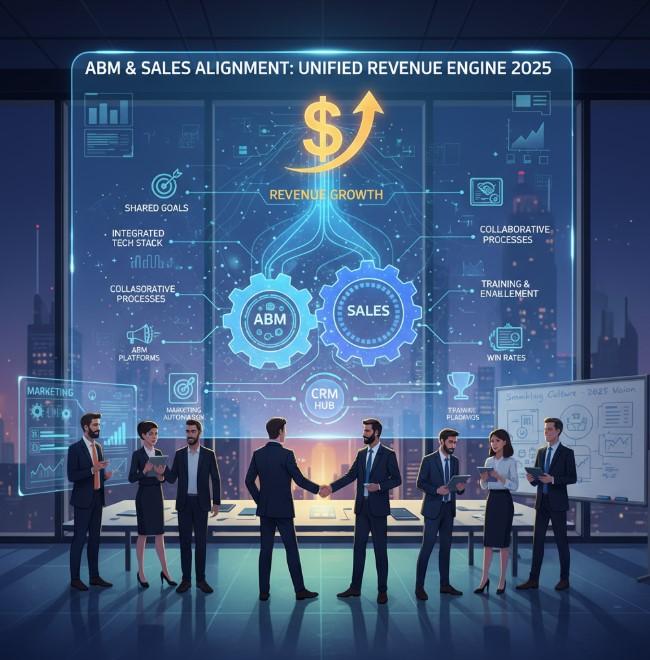ABM and Sales Alignment: How to Build a Unified Revenue Engine in 2025

In 2025, the B2B marketing and sales landscape is evolving at breakneck speed. The rise of AI, automation, and intent data has transformed how businesses engage with high-value accounts. Yet, one constant remains: the need for tight alignment between marketing and sales.
Account-Based Marketing (ABM) thrives when marketing and sales teams function as a single unit—sharing insights, collaborating on account engagement, and co-owning pipeline goals. However, silos, misaligned KPIs, and outdated processes often derail success.
This blog will explore how ABM can align marketing and sales into a unified revenue engine, why it matters in 2025, challenges that still exist, proven strategies for alignment, and what the future holds.
What is ABM and Why It Matters for Sales Alignment?
At its core, Account-Based Marketing (ABM) is a growth strategy where marketing and sales collaborate to engage a defined set of high-value accounts with personalized campaigns. Unlike traditional lead generation, ABM is account-first, requiring both teams to align on:
- Which accounts to target
- What pain points matter most
- How to tailor outreach
- How to measure success
📊 Data point: According to Forrester, companies with tightly aligned sales and marketing achieve 24% faster revenue growth and 27% higher profitability than competitors.
In 2025, alignment matters more than ever because:
- Buying committees are larger (6–10 stakeholders per deal).
- Sales cycles are longer and more complex.
- Buyers expect seamless, consistent messaging across all touchpoints.
Without alignment, deals stall, opportunities are missed, and revenue leakage skyrockets.
Challenges in ABM & Sales Alignment
Even though ABM promises alignment, many B2B organizations face persistent challenges:
- Siloed Data and Tools
- Marketing may run campaigns on intent platforms while sales relies on outdated CRMs.
- Without unified data, insights are fragmented.
- Conflicting KPIs
- Marketing tracks MQLs, while sales cares about closed deals.
- Misaligned metrics lead to finger-pointing instead of collaboration.
- Content Disconnect
- Marketing creates assets that don’t reflect real buyer conversations.
- Sales often abandons marketing content and builds their own.
- Lack of Real-Time Collaboration
- Sales and marketing rarely review account engagement data together.
- Opportunities slip because handoffs are delayed.
- Scaling Personalization
- Both teams struggle to deliver personalization across hundreds of accounts without burning out.
Proven Strategies to Align ABM and Sales Teams
1. Build a Shared Ideal Customer Profile (ICP)
- Co-create ICPs based on historical win data, firmographics, technographics, and intent signals.
- Involve sales early to ensure the ICP reflects ground realities.
- Continuously refine ICPs as buyer behavior evolves.
2. Define Joint Success Metrics
- Replace MQL-based goals with account-based metrics such as:
- Account engagement score
- Pipeline velocity
- Win rate by tier
- Revenue influenced by ABM
- Celebrate wins together instead of in silos.
3. Create Account Plans Together
- Marketing brings buyer journey insights.
- Sales brings real-world objections and deal context.
- Together, they design account-based plays with specific messaging, touchpoints, and timelines.
4. Orchestrate Omnichannel Campaigns
- Align efforts across email, LinkedIn, webinars, content syndication, and events.
- Ensure consistent messaging across every channel.
- Example: If marketing runs an industry-specific webinar, sales should follow up with personalized outreach to attendees.
5. Establish Real-Time Feedback Loops
- Use revenue intelligence tools to monitor account engagement.
- Weekly syncs between marketing and sales teams to discuss active accounts.
- Create a culture where insights (both wins and failures) are openly shared.
6. Leverage AI and Automation
- Use AI-driven platforms to prioritize accounts showing intent.
- Automate account scoring and routing.
- Deploy generative AI for personalized sales enablement content at scale.
Trends and the Future of ABM & Sales Alignment in 2025
- AI-Powered Account Insights
- Predictive analytics will identify deal risks early, enabling both teams to pivot strategies proactively.
- Revenue Operations (RevOps) as the Glue
- RevOps will serve as the central function aligning data, processes, and tools across marketing, sales, and customer success.
- Hyper-Personalization at Scale
- AI-driven personalization engines will allow teams to craft 1:1 experiences even for hundreds of accounts simultaneously.
- Shift from Leads to Buying Committees
- Engagement strategies will target multiple stakeholders within the same account, ensuring sales and marketing efforts align with group decision-making.
- Full-Funnel ABM
- ABM will extend beyond acquisition to include upsell, cross-sell, and renewal campaigns—where sales alignment is even more crucial.
Pro Tips & Bonus Insights
- Executive Sponsorship Matters: Senior leadership must champion alignment to avoid reverting to old silos.
- Shared Dashboards: Invest in ABM platforms where both teams can view engagement and pipeline progression in real time.
- Celebrate Joint Wins: Highlight co-created deals in team meetings to foster a culture of shared success.
- Test and Learn: Pilot ABM campaigns with a few accounts, gather feedback, then scale across more accounts.
Conclusion
ABM in 2025 is no longer just about targeted campaigns—it’s about building a unified revenue engine where marketing and sales move in lockstep. Alignment means co-owning ICPs, metrics, account plans, and pipeline outcomes.
With AI, automation, and intent data, organizations have the tools to achieve unprecedented precision and efficiency. The companies that succeed will be the ones who break down silos, measure what matters, and put the buyer at the center.
- Art
- Causes
- Crafts
- Dance
- Drinks
- Film
- Fitness
- Food
- Oyunlar
- Gardening
- Health
- Home
- Literature
- Music
- Networking
- Other
- Party
- Religion
- Shopping
- Sports
- Theater
- Wellness




